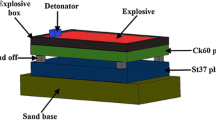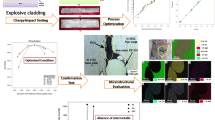Abstract
Though explosive cladding is a viable potential solid state method for cladding different materials together, complicated behavior of materials under ballistic impacts raises the probability of interfacial shear failure. This study aims to relate the failure of explosive cladding of Inconel 625 and plain carbon steel to utilized impact energy, and consequently finding appropriate cladding parameters to prevent interfacial shear failure. The shear strength representing the adhesion strength is used as a failure criterion. According to the obtained results, by increasing the impact energy to an optimum value, the adhesion strength starts to increase. However, after an optimum value, any further increment of impact energy drops the shear strength significantly, which makes the cladding process fail. The outcomes reveal the decisive role of plastic strain localization caused by high impact energies in this failure, where local development of microcracks through adiabatic shear bands in the steel raises the chance of failure. Consequently, an attempt is made to find the optimum cladding parameters to prevent strain localization and failure of cladding.











Similar content being viewed by others
References
Kohl, H.K., Peng, K.: Thermal stability of the superalloys Inconel 625 and Nimonic 86. J. Nucl. Mater. 101, 243–250 (1981)
Sexton, L., Lavin, S., Byrne, G., Kennedy, A.: Laser cladding of aerospace materials. J. Mater. Process. 122, 63–68 (2002)
Dinda, G.P., Dasgupta, A.K., Mazumder, J.: Laser aided direct deposition of Inconel 625 superalloy: microstructural evolution and thermal stability. Mater. Sci. Eng. A 509, 98–104 (2009)
Ramirez, A.J., Lippold, J.C.: High temperature behavior of Ni-base weld metal Part II—insight into the mechanism for ductility dip cracking. Mater. Sci. Eng. A 380, 245–258 (2004)
Zhang, D., Harris, S.J., McCartney, D.G.: Microstructure formation and corrosion behaviour in HVOF-sprayed Inconel 625 coatings. Mater. Sci. Eng. A 344, 45–56 (2003)
Panl, C.P., Ganesh, P., Mishra, S.K., Bhargava, P., Negi, J., Nath, A.K.: Investigating laser rapid manufacturing for inconel-625 components. Opt. Laser 39, 800–805 (2007)
Ogborn, J.S., Olson, D.L., Cieslak, M.J.: Influence of solidification on the microstructural evolution of nickel base weld metal. Mater. Sci. Eng. 203, 134–139 (1995)
Blazynski, T.Z.: Explosive welding, forming and compaction. Applied Science Publishers, London (1985)
Vaidyanthan, P.V., Rathinasabapathi, M., Ramanathan, A.R.: A note on the estimation of flyer plate velocity in explosive cladding. J. Mech. Work. Technol. 18, 343–350 (1998)
DIN 50162 Standard, DIN Handbook, 1998
Crossland, B.: Explosive welding of metals and its application. Clarendon Press, Oxford (1982)
Xue-Bin, W.: Effect of constitutive parameters on adiabatic shear localization for ductile metal based on JOHNSON–COOK and gradient plasticity models. Trans. Nonferrous Metal. Soc. 16, 1362–1369 (2006)
Gong, X., Fan, J.L., Huang, B.Y., Tian, J.M.: Microstructure characteristics and a deformation mechanism of fine grained tungsten heavy alloy under high strain rate compression. Mater. Sci. Eng. A 527, 7565–7570 (2010)
Backman, M.E., Finnegan, S.A.: In metallurgical effects at high strain rate. Plenum Press, New York (1973)
Walley, S.M.: Shear localization: a historical overview. Metall. Mater. Trans. A 38, 2629–2654 (2007)
Molinari, A., Clifton, R.J.: Analytical characterization of shear localization in thermoviscoplastic materials. J. Appl. Mech. T ASME 54, 806–812 (1987)
Duffy, J., Chi, Y.C.: On the measurement of local strain and temperature during the formation of adiabatic shear bands. Mater. Sci. Eng. A 157, 195–210 (1992)
Coleman, B.D., Hodgdon, M.L.: On localization of strain shearing motions of ductile materials. Res. Mech. 23, 223–238 (1988)
Xu, Y.B., Zhong, W.L., Chen, Y.J., Shen, L.T., Liu, Q., Bai, Y.L., Meyers, M.A.: Microstructure and properties of magnesium–aluminum explosively welded composite plate. Mater. Sci. Eng. A 299, 287–295 (2001)
Coleman, B.D., Hodgdon, M.L.: On shear bands in ductile materials. Arch. Ration. Mech. Anal. 90, 219–247 (1985)
Dieter, G.E.: Mechanical Metallurgy, 3rd edn, pp. 241–272. Mc Graw Hill, Boston (1986)
Author information
Authors and Affiliations
Corresponding author
Rights and permissions
About this article
Cite this article
Zareie Rajani, H.R., Akbari Mousavi, S.A.A. The Role of Impact Energy in Failure of Explosive Cladding of Inconel 625 and Steel. J Fail. Anal. and Preven. 12, 646–653 (2012). https://doi.org/10.1007/s11668-012-9601-1
Received:
Revised:
Published:
Issue Date:
DOI: https://doi.org/10.1007/s11668-012-9601-1




